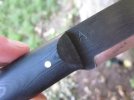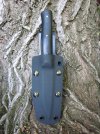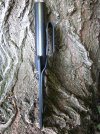- Joined
- Dec 1, 2007
- Messages
- 3,798
Adam Gray has been on this forum for a while and even has his own subforum, but remains a bit obscure. I'll do my part to help spread the word about his stuff by reviewing the one AA Forge knife I own - the Scandi Bushcrafter.
The design is extremely simple and efficient... no guard, choil, jimping, or lanyard tube. It is built from 1/8" thick O1 steel with forge-finished blade flats, 8 1/2" long overall with a 4" flat scandi ground edge. The blade flares slightly out from the handle and is exactly 1" wide at the base. The spine has a gradual and continuous curve from the handle to the tip, and the cutting edge runs straight for about two inches before curving upward to the tip. The tip is positioned about 3/16" higher than the centerline, making the blade somewhat of a hybrid betwen a spearpoint and drop point configuration.
The handle features a full exposed tang with black linen micarta scales and brass pins. The handles are nicely rounded, which is an excellent feature on an exposed-tang knife. This design combines the comfort of the oval-shaped handles on stick-tang knives with the strength of full tang construction. The handles have very slight contouring and flats ground in at the top for side-grip positions. It is smooth and amazingly comfortable.
Adam supplied a kydex sheath by Gray Wolf Knives (Aaron Gray), who is perhaps related to Adam (just a guess). This sheath fits the knife like a glove - the blade locks in tight and draws smoothly with little noise and friction. This knife has been in and out of its sheath more times than I can remember by now, and I can see only one area where the kydex has left some small marks.
An addition to the sheath is an open-construction belt loop with a slight barb on the inside. The sheath can quickly be snapped onto my belt and no-so quickly removed as the barb snags the bottom of my belt quite nicely. Getting it off is actually a bit of a chore, which is of course the whole point. It reminds me a bit of Bud Nealy's MCSII barbed metal clip, and is an excellent design that was perfectly executed.
Right out of the box I noticed that this was possibly the sharpest knife I've ever purchased. Upon closer inspection I realized that the grinds were absolutely perfect. The blade bevels and scales are almost mirror images of each other. Having bought many custom knives, I'm pretty much used to uneven grinds and have gotten to the point where they have to be atrocious before I even bother complaining about them. I suppose even grinds still do matter to some makers, as can clearly be seen on this knife.
In use I found it held an edge well and was very easily stropped back to razor sharpness using only a piece of cardboard. Field maintenance was clearly a breeze. The blade is forming a bit of a patina, and in a few weeks I expect the edge to be as dark as the flats.
Whether I'm fishing, camping, hiking, or otherwise "in the field," I think this can and will do it all. It's compact, sturdy, and comfortable, with an edge geometry that cuts cleanly, drills nicely, maintains easily, can handle tough chores and still pick out a splinter without tearing a hole in my hand. For everything I want in a knife, and with everything I know about how they are built and how they perform, I would still be hard pressed to design a knife better than this. I will be getting a Fiddleback Terrasaur soon, which is another super-clean design I've been wanting to try out. So the AA Forge Scandi Bushcrafter will soon have a worthy contestant, and I may have to post a follow-up once these two have gone head-to-head.
Thank you Adam for the fantastic knife, and thank you all for reading!
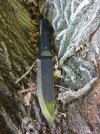
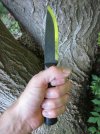


The design is extremely simple and efficient... no guard, choil, jimping, or lanyard tube. It is built from 1/8" thick O1 steel with forge-finished blade flats, 8 1/2" long overall with a 4" flat scandi ground edge. The blade flares slightly out from the handle and is exactly 1" wide at the base. The spine has a gradual and continuous curve from the handle to the tip, and the cutting edge runs straight for about two inches before curving upward to the tip. The tip is positioned about 3/16" higher than the centerline, making the blade somewhat of a hybrid betwen a spearpoint and drop point configuration.
The handle features a full exposed tang with black linen micarta scales and brass pins. The handles are nicely rounded, which is an excellent feature on an exposed-tang knife. This design combines the comfort of the oval-shaped handles on stick-tang knives with the strength of full tang construction. The handles have very slight contouring and flats ground in at the top for side-grip positions. It is smooth and amazingly comfortable.
Adam supplied a kydex sheath by Gray Wolf Knives (Aaron Gray), who is perhaps related to Adam (just a guess). This sheath fits the knife like a glove - the blade locks in tight and draws smoothly with little noise and friction. This knife has been in and out of its sheath more times than I can remember by now, and I can see only one area where the kydex has left some small marks.
An addition to the sheath is an open-construction belt loop with a slight barb on the inside. The sheath can quickly be snapped onto my belt and no-so quickly removed as the barb snags the bottom of my belt quite nicely. Getting it off is actually a bit of a chore, which is of course the whole point. It reminds me a bit of Bud Nealy's MCSII barbed metal clip, and is an excellent design that was perfectly executed.
Right out of the box I noticed that this was possibly the sharpest knife I've ever purchased. Upon closer inspection I realized that the grinds were absolutely perfect. The blade bevels and scales are almost mirror images of each other. Having bought many custom knives, I'm pretty much used to uneven grinds and have gotten to the point where they have to be atrocious before I even bother complaining about them. I suppose even grinds still do matter to some makers, as can clearly be seen on this knife.
In use I found it held an edge well and was very easily stropped back to razor sharpness using only a piece of cardboard. Field maintenance was clearly a breeze. The blade is forming a bit of a patina, and in a few weeks I expect the edge to be as dark as the flats.
Whether I'm fishing, camping, hiking, or otherwise "in the field," I think this can and will do it all. It's compact, sturdy, and comfortable, with an edge geometry that cuts cleanly, drills nicely, maintains easily, can handle tough chores and still pick out a splinter without tearing a hole in my hand. For everything I want in a knife, and with everything I know about how they are built and how they perform, I would still be hard pressed to design a knife better than this. I will be getting a Fiddleback Terrasaur soon, which is another super-clean design I've been wanting to try out. So the AA Forge Scandi Bushcrafter will soon have a worthy contestant, and I may have to post a follow-up once these two have gone head-to-head.
Thank you Adam for the fantastic knife, and thank you all for reading!




Last edited:


